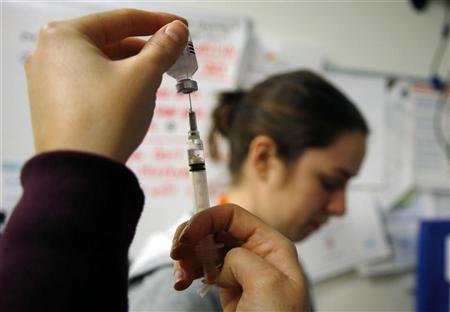
© REUTERS/Brian Snyder
The worst U.S. flu season since 2009 intensified last week, killing hundreds more people as the viral epidemic spread to additional states, health officials said.
About 8.3 percent of all deaths nationwide were due to the flu and pneumonia for the week ended Jan. 12, more than the 7.3 percent level for an epidemic, the Centers for Disease Control and Prevention said today. About 90 percent of those deaths are people older than age 65, who are being hit particularly hard by this year's flu strain, the Atlanta-based agency said.
The flu season, which has now been at epidemic levels for two straight weeks, may result in 36,000 deaths, said William Schaffner, chairman of the department of preventive medicine at Vanderbilt University School of Medicine in Nashville, Tennessee. Infections will likely persist through February and March though cases may have peaked in some regions, including the East Coast and Southeast, he said.
"We are right in the middle," Schaffner said in a telephone interview. "Influenza just doesn't turn off like a light switch. It may be that in many part of the country it has plateaued and we are seeing some downturns. But we are continuing to see patients hospitalized."
The outbreak is widespread in 48 states with 30 seeing high levels, the CDC said today. Cases are starting to increase on the West Coast, which hadn't been hit as severely as the Midwest and eastern states, the agency said. From Dec. 3 through Jan. 12, there have been 5,643 deaths from flu and pneumonia, which is often caused by the flu, the CDC data show.
Finding VaccinesCVS Caremark Corp. (CVS) and Rite Aid Corp. (RAD), two of the largest U.S. drugstore chains, said they are working to restock flu vaccines as a rush of consumers seeking the immunization depletes supply. Rite Aid said yesterday it obtained an extra 400,000 doses of the vaccine that began arriving in stores this week. While the Food and Drug Administration confirmed there are spot shortages, the agency said there isn't a widespread lack of supply and people should be able to find flu shots if they go to multiple drugstores and clinics.
"We cannot increase the actual production of vaccine for this current flu season," FDA Commissioner Margaret Hamburg said today on a conference call with reporters. "But there is a lot of reason to believe vaccine is out there and not getting to the people who need it."
Vaccine makers are expected to produce 145 million doses for the current flu season, more than initially projected, Hamburg said. During a typical season, 1 million doses a day are given to patients.
Insect VirusPossibly helping the supply was the FDA's approval Jan. 16 of one company's more efficient way to make the flu vaccine, which typically takes about six months to produce. Protein Sciences Corp., based in Meriden, Connecticut, won clearance for FluBlok, which the closely held company said can be produced in less than two months by inserting flu genes into an insect virus and then growing the active protein for the immunization.
The product is intended to help move away from the 50-year- old technique of growing the vaccine in chicken eggs, a process that has been blamed for delays in reacting to unanticipated flu outbreaks.
Health officials were caught off-guard last month when the flu season started earlier than in past years. Among this season's deaths, 29 have been children. There were nine pediatric deaths in the week ended Jan. 12, a 45 percent increase from the previous week, according to the CDC.
It's more than worthwhile to read Jon Rappoport on the CDC's "statistics" as year after year their stats have been shown to be little more than doom-and-gloom scare tactics based on wishful thinking.
Jon's a wa-a-a-y up to speed on all that and has been for years and years . . .